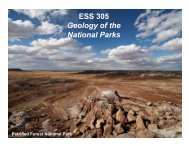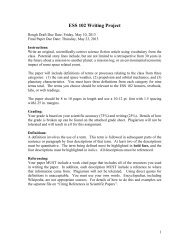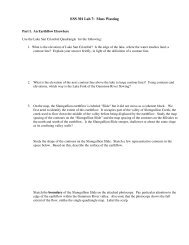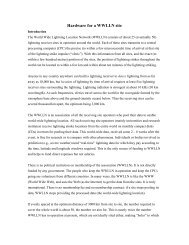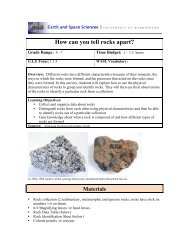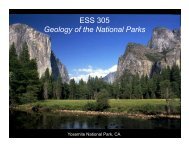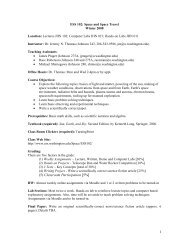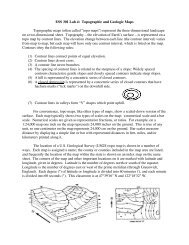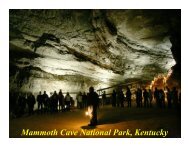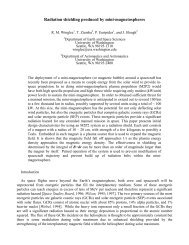Definition of a continuum. - Earth and Space Sciences
Definition of a continuum. - Earth and Space Sciences
Definition of a continuum. - Earth and Space Sciences
Create successful ePaper yourself
Turn your PDF publications into a flip-book with our unique Google optimized e-Paper software.
is usually called stress or sometimes traction.<br />
If one considers some <strong>of</strong> the earlier examples, it is clear that there is also<br />
a problem <strong>of</strong> scale in defining the body force <strong>and</strong> stress. Air pressure is a<br />
surface force (stress) that arises from the time/space average <strong>of</strong> molecules<br />
impinging on a surface. Stress in deforming s<strong>and</strong> would represent the mean<br />
force per unit area arising from the local forces acting across particle contacts.<br />
The question <strong>of</strong> whether a material (or materials) can be considered a<br />
<strong>continuum</strong> for the solution <strong>of</strong> some practical problem or analysis <strong>of</strong> some<br />
data is <strong>of</strong>ten a subjective matter. The concept <strong>of</strong> a <strong>continuum</strong> is an idealization,<br />
which may approximate reality, when one looks in appropriate distance<br />
<strong>and</strong> time averages. Usually in geophysics we find examples where the concept<br />
<strong>of</strong> a <strong>continuum</strong> is clearly applicable. A dense plasma, atmospheric air,<br />
ocean water, glacier ice, a large body <strong>of</strong> granite are examples. However, there<br />
are cases where the answer is not so clear. Suppose a large body <strong>of</strong> granite<br />
is cracked (has joints) every several or several tens <strong>of</strong> meters <strong>and</strong> we consider<br />
some relevant constitutive property, for example, the way water moves<br />
through it (permeability). As a whole the body will not behave the same<br />
way as a small sample <strong>of</strong> coherent granite behaves in a lab test. Possibly on<br />
an averaging scale <strong>of</strong> several hundred meters we could idealize the body as<br />
a <strong>continuum</strong> (e.g. permeability <strong>of</strong> cracked granite), but this is not always<br />
obvious.<br />
The goal <strong>of</strong> <strong>continuum</strong> mechanics is to predict the distribution <strong>of</strong> displacements<br />
<strong>and</strong> forces within a body when prescribed forces <strong>and</strong>/or displacements<br />
are applied to its outer surface. To do this we must learn how to (1) describe<br />
the essential aspects <strong>of</strong> the displacement field, (2) describe the state <strong>of</strong> forces,<br />
<strong>and</strong> (3) have knowledge <strong>of</strong> the mechanical behavior <strong>of</strong> the material (i.e., kinematic<br />
response to certain forces). Essentially this boils down to learning how<br />
to predict the response <strong>of</strong> an arbitrary continuous body under arbitrary surface<br />
loads or displacements from the results <strong>of</strong> several simple experiments<br />
such as stretching a rod or twisting a cylinder. This is especially successful<br />
when the <strong>continuum</strong> is one on a scale <strong>of</strong> mm, cm, or even meters which can<br />
be h<strong>and</strong>led in the lab. In geophysics we are <strong>of</strong>ten stuck with a larger scale<br />
<strong>and</strong> must rely on natural experiments.<br />
4



